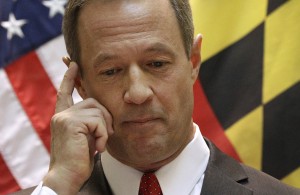Maryland Governor proposes stringent fracking regulations

Maryland Gov. Martin O'Malley delivers his annual State of the State address to a joint session of the legislature in Annapolis, Md., Thursday, Jan. 23, 2014. After three years of research, the term-limited governor has proposed strict regulations on fracking. But it's unclear what will become of them once he leaves office in January.
Marcellus Shale natural gas deposits lie beneath just a tiny sliver of western Maryland. But with three years worth of review, the state issued a 104 page report Tuesday detailing the pros and cons of fracking, along with recommendations for some of the most stringent rules in the country. Maryland’s Marcellus Shale Safe Drilling Initiative Study was conducted by the state’s Department of Environment, and Department of Natural Resources at the behest of the outgoing governor, Martin O’Malley. It’s unclear what will come of the proposal because the newly elected incoming governor-elect, Republican Larry Hogan, has criticized the lack of drilling in the state’s two shale gas counties.
The hold up to Maryland’s shale gas boom has been the state’s extensive analysis of current research into the economic, public health and environmental impacts of fracking. Today’s report includes a long list of proposed recommendations that it says would allow gas drilling to occur with minimal risks.
“…provided all the recommended best practices are followed and the State is able to rigorously monitor and enforce compliance, the risks of Marcellus Shale development can be managed to an acceptable level.”
The proposed regulations include a five-year plan on each well, a 2000 foot vertical buffer between an aquifer and the targeted gas deposit, a setback of at least 1000 feet from the edge of a well pad to an occupied building, school or church and 2000 feet from a private drinking water well.
When drilling the first 100 feet of the well, or drilling through drinking water aquifers, only water and air may be used, or chemicals that meet certain safety requirements. Regular cement casing integrity tests will have to be performed on each well. Both fracking with diesel and open pit frack water storage ponds will not be permitted. Fracking chemical disclosures are discussed in detail, and expressly state that health care professionals would be able to gain access to information quickly, and be able to share that information with the patient.
Perhaps one of the most novel regulations regard methane leaks. The Maryland proposal requires operators to fix leaks, and measure the amount of methane that does end up escaping during production and transport into the interstate transmission lines. Methane is a greenhouse gas that in the short term causes more warming impacts than carbon dioxide. Environmentalists and climate scientists are increasingly concerned about methane, and oil and gas operations are considered the highest industrial emitters of the greenhouse gas. Estimated leaks by the oil and gas industry vary, but many say the global warming impacts of those emissions outweigh the climate benefits of burning natural gas over coal. The Environmental Protection Agency is expected to release new rules regarding methane emissions from the oil and gas sector by the end of this year.

Republican Larry Hogan, Maryland's governor-elect, says he has doubts humans contribute to climate change.
In addition to plugging onsite methane leaks, the gas drillers would have to measure the amount of methane that does escape, and purchase carbon off-sets to make up for those emissions.
Mike Tidwell, executive director of the Chesapeake Climate Action Network, says Governor Martin O’Malley’s proposal is both novel and encouraging.
“This is the first time as far as we know that any governor or government anywhere in the world has proposed a policy of zero methane leakage,” said Tidwell. “And we’re hoping that this idea coming from Maryland might influence other states and even influence the EPA in terms of future regulations.”
Tidwell says for environmental and public health reasons, he hopes fracking never comes to Maryland. But in places where it already exists, he says Maryland’s proposals could provide a model for ideal regulation.
Although the new governor could ignore O’Malley’s proposals, Democrats in Maryland’s legislature maintain a super-majority, which means they could override a veto. Read the entire report below:
















